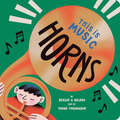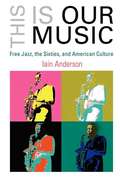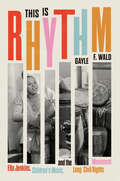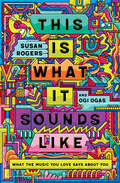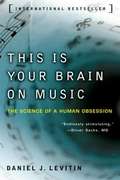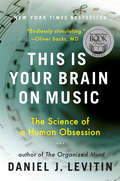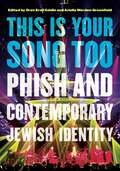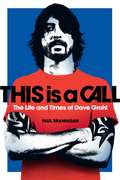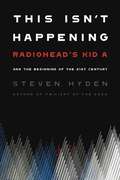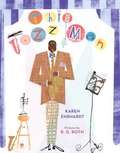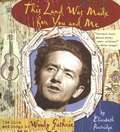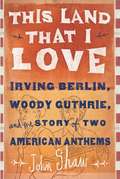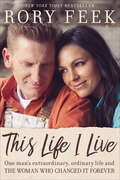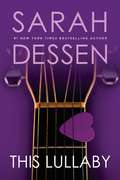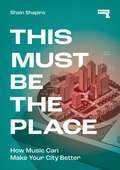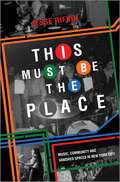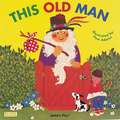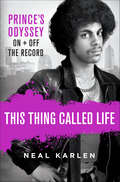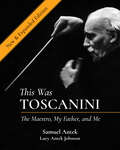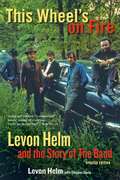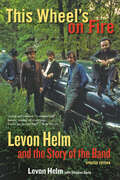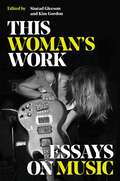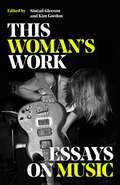- Table View
- List View
This Is Music: Horns
by Rekha S. RajanMake music with this hands-on introduction to the four instrument families: drums, horns, strings, and voice in this new board book series by a world-renown music educator.What do a trumpet, a tuba, and a conch shell have in common? They are all horns! This first introduction to instruments in the horn family begins with a simple explanation of what defines a horn. Young readers are then invited on a global exploration of a variety of brass and wind instruments and are encouraged to find horns of their own in the world around them. Each title in the THIS IS MUSIC series features an interactive novelty musical element that invites the reader to "play" the book!
This Is Our Music
by Iain AndersonThis Is Our Music, declared saxophonist Ornette Coleman's 1960 album title. But whose music was it? At various times during the 1950s and 1960s, musicians, critics, fans, politicians, and entrepreneurs claimed jazz as a national art form, an Afrocentric race music, an extension of modernist innovation in other genres, a music of mass consciousness, and the preserve of a cultural elite. This original and provocative book explores who makes decisions about the value of a cultural form and on what basis, taking as its example the impact of 1960s free improvisation on the changing status of jazz. By examining the production, presentation, and reception of experimental music by Ornette Coleman, Cecil Taylor, John Coltrane, and others, Iain Anderson traces the strange, unexpected, and at times deeply ironic intersections between free jazz, avant-garde artistic movements, Sixties politics, and patronage networks. Anderson emphasizes free improvisation's enormous impact on jazz music's institutional standing, despite ongoing resistance from some of its biggest beneficiaries. He concludes that attempts by African American artists and intellectuals to define a place for themselves in American life, structural changes in the music industry, and the rise of nonprofit sponsorship portended a significant transformation of established cultural standards. At the same time, free improvisation's growing prestige depended in part upon traditional highbrow criteria: increasingly esoteric styles, changing venues and audience behavior, European sanction, withdrawal from the marketplace, and the professionalization of criticism. Thus jazz music's performers and supporters--and potentially those in other arts--have both challenged and accommodated themselves to an ongoing process of cultural stratification.
This Is Rhythm: Ella Jenkins, Children’s Music, and the Long Civil Rights Movement
by Gayle F. WaldThe remarkable life story of Ella Jenkins, “The First Lady of Children’s Music.” Ella Jenkins was one of the most influential musicians of the twentieth century. Her songs “You’ll Sing a Song and I’ll Sing a Song” and “Who Fed the Chickens?” are classics in the world of children’s music. In a career spanning more than sixty years, she recorded forty albums, won a lifetime-achievement Grammy, and became the best-selling individual artist in the history of Smithsonian Folkways Records, the independent label that played a significant role in the 1960s folk revival movement and introduced listeners to Woody Guthrie and Pete Seeger. During her remarkable career, Jenkins joined forces with twentieth-century luminaries such as Odetta, Big Bill Broonzy, Armando Peraza, Bayard Rustin, and Fred Rogers. Despite her wide-reaching influence on children’s music, Ella Jenkins’s sonic civil rights activism isn’t widely known today. Based on dozens of interviews and access to Ella Jenkins’s personal archives, Gayle F. Wald’s This Is Rhythm shares how Jenkins, a “rhythm specialist” with no formal musical training, became the most prolific and significant American children’s musician of the twentieth century, creating a beloved catalog of songs grounded in values of community-building, antiracism, and cultural pluralism. Wald traces how the daughter of southern migrants translated the music of her own Black girlhood on the South Side of Chicago into a form of civil rights activism—a musical education that empowered children by introducing them to Black history, African diasporic rhythms, and a participatory, community-centered approach to music. Wald also discusses how, beginning in 1961, Jenkins built a life with a female partner who supported her materially and emotionally. Although Jenkins did not talk publicly about her sixty-three-year relationship, she opened up to Wald, offering insight into how a “private” Black woman in the public eye negotiated sexuality in an era before gay and lesbian liberation movements. Throughout her career, her innovative music found its way into thousands of community centers, classrooms, and concert venues, and her “call-and-response” method has influenced and empowered generations of children and adults. A beautifully written tribute to Ella Jenkins’s legacy, this biography illustrates her impact on children’s music and expands our understanding of folk music’s relationship with social justice. Jenkins used music to build a new world in which children—and adults—are encouraged to listen to each other’s distinct rhythms.
This Is What It Sounds Like: What the Music You Love Says About You
by Ogi Ogas Susan RogersNamed one of the Most Anticipated Books of 2022 by Boston Globe and Literary Hub A legendary record producer–turned–brain scientist explains why you fall in love with music. This Is What It Sounds Like is a journey into the science and soul of music that reveals the secrets of why your favorite songs move you. But it’s also a story of a musical trailblazer who began as a humble audio tech in Los Angeles, rose to become Prince’s chief engineer for Purple Rain, and then created other No. 1 hits ,including Barenaked Ladies' "One Week," as one of the most successful female record producers of all time. Now an award-winning professor of cognitive neuroscience, Susan Rogers leads readers to musical self-awareness. She explains that we each possess a unique “listener profile” based on our brain’s natural response to seven key dimensions of any song. Are you someone who prefers lyrics or melody? Do you like music “above the neck” (intellectually stimulating), or “below the neck” (instinctual and rhythmic)? Whether your taste is esoteric or mainstream, Rogers guides readers to recognize their musical personality, and offers language to describe one's own unique taste. Like most of us, Rogers is not a musician, but she shows that all of us can be musical—simply by being an active, passionate listener. While exploring the science of music and the brain, Rogers also takes us behind the scenes of record-making, using her insider’s ear to illuminate the music of Prince, Frank Sinatra, Kanye West, Lana Del Rey, and many others. She shares records that changed her life, contrasts them with those that appeal to her coauthor and students, and encourages you to think about the records that define your own identity. Told in a lively and inclusive style, This Is What It Sounds Like will refresh your playlists, deepen your connection to your favorite artists, and change the way you listen to music.
This Is Your Brain on Music: The Science of a Human Obsession
by Daniel J. LevitinWhether you load your iPod with Bach or Bono, music has a significant role in your life - even if you never realized it. Why does music evoke such powerful moods? The answers are at last becoming clear, thanks to revolutionary neuroscience and the emerging field of evolutionary psychology. Both a cutting-edge study and a tribute to the beauty of music itself, This Is Your Brain on Music unravels a host of mysteries that affect everything from pop culture to our understanding of human nature, including: Are our musical preferences shaped in utero? Is there a cutoff point for acquiring new tastes in music? What do PET scans and MRIs reveal about the brain's response to music? Is musical pleasure different from other kinds of pleasure? This Is Your Brain on Music explores cultures in which singing is considered an essential human function, patients who have a rare disorder that prevents them from making sense of music, and scientists studying why two people may not have the same definition of pitch. At every turn, this provocative work unlocks deep secrets about how nature and nurture forge a uniquely human obsession.
This Is Your Brain on Music: The Science of a Human Obsession
by Daniel J. LevitinWhat can music teach us about the brain? What can the brain teach us about music? And what can both teach us about ourselves? In this groundbreaking union of art and science, rocker-turned-neuroscientist Daniel J. Levitin (The World in Six Songs and The Organized Mind) explores the connection between music - its performance, its composition, how we listen to it, why we enjoy it - and the human brain. Drawing on the latest research and on musical examples ranging from Mozart to Duke Ellington to Van Halen, Levitin reveals:How composers produce some of the most pleasurable effects of listening to music by exploiting the way our brains make sense of the worldWhy we are so emotionally attached to the music we listened to as teenagers, whether it was Fleetwood Mac, U2, or Dr. DreThat practice, rather than talent, is the driving force behind musical expertiseHow those insidious little jingles (called earworms) get stuck in our headTaking on prominent thinkers who argue that music is nothing more than an evolutionary accident, Levitin poses that music is fundamental to our species, perhaps even more so than language. A Los Angeles Times Book Award finalist, This Is Your Brain on Music will attract readers of Oliver Sacks and David Byrne, as it is an unprecedented, eye-opening investigation into an obsession at the heart of human nature.
This Is Your Song Too: Phish and Contemporary Jewish Identity (Dimyonot)
by Oren Kroll-Zeldin and Ariella Werden-GreenfieldPhish has a diehard fan base and a dedicated community of enthusiasts—called Phishheads—who follow the band around the country, some fans attending every show. What may be surprising is that a significant percentage of Phishheads are Jewish.Two members of the band—bassist Mike Gordon and drummer Jonathan Fishman—were raised in Jewish households, and Phish has been known to play Hebrew songs in concert. At live shows, many attendees, some wearing T-shirts emblazoned with “Phish” written in Hebrew letters, express feeling something special—even distinctly Jewish—during their performances. As this book shows, Phish is one avenue through which many Jews find cultural and spiritual fulfillment outside the confines of traditional and institutional Jewish life. In effect, Phish fandom and the live Phish experience act as a microcosm through which we see American Jewish religious and cultural life manifest in unique and unexpected spaces.Featuring an interview with Mike Gordon and a collection of fascinating photographs, This Is Your Song Too is an in-depth look at Jewishness in the Phish universe that also provides a deeper understanding of how spirituality, ritual, and identity function in the world of rock and roll.In addition to the editors, the contributors include Evan S. Benn, Dean Budnick, Jacob A. Cohen, Benjamin David, Jessy Dressin, Josh Fleet, Mike Greenhaus, Joshua S. Ladon, Noah Munro Lehrman, Caroline Rothstein, and Isaac Kandall Slone.
This Is a Call: The Life and Times of Dave Grohl
by Paul BranniganThe first biography of Dave Grohl, drummer for the legendary band Nirvana and singer/songwriter for the Foo Fighters
This Isn't Happening: Radiohead's "Kid A" and the Beginning of the 21st Century
by Steven HydenTHE MAKING AND MEANING OF RADIOHEAD'S GROUNDBREAKING, CONTROVERSIAL, EPOCHDEFINING ALBUM, KID A. In 1999, as the end of an old century loomed, five musicians entered a recording studio in Paris without a deadline. Their band was widely recognized as the best and most forward-thinking in rock, a rarefied status granting them the time, money, and space to make a masterpiece. But Radiohead didn't want to make another rock record. Instead, they set out to create the future. For more than a year, they battled writer's block, intra-band disagreements, and crippling self-doubt. In the end, however, they produced an album that was not only a complete departure from their prior guitar-based rock sound, it was the sound of a new era-and it embodied widespread changes catalyzed by emerging technologies just beginning to take hold of the culture. What they created was Kid A. Upon its release in 2000, Radiohead's fourth album divided critics. Some called it an instant classic; others, such as the UK music magazine Melody Maker, deemed it "tubby, ostentatious, self-congratulatory... whiny old rubbish." But two decades later, Kid A sounds like nothing less than an overture for the chaos and confusion of the twenty-first century. Acclaimed rock critic Steven Hyden digs deep into the songs, history, legacy, and mystique of Kid A, outlining the album's pervasive influence and impact on culture in time for its twentieth anniversary in 2020. Deploying a mix of criticism, journalism, and personal memoir, Hyden skillfully revisits this enigmatic, alluring LP and investigates the many ways in which Kid A shaped and foreshadowed our world.
This Jazz Man
by Karen EhrhardtIn this toe-tapping jazz tribute, the traditional "This Old Man" gets a swinging makeover, and some of the era's best musicians take center stage. The tuneful text and vibrant illustrations bop, slide, and shimmy across the page as Satchmo plays one, Bojangles plays two . . . right on down the line to Charles Mingus, who plays nine, plucking strings that sound "divine. " Easy on the ear and the eye, this playful introduction to nine jazz giants will teach children to count--and will give them every reason to get up and dance! Includes a brief biography of each musician.
This Land Was Made for You and Me: The Life and Songs of Woody Guthrie
by Elizabeth Partridge<P>Before Springsteen and before Dylan, there was Woody Guthrie. With "This Machine Kills Fascists" scrawled across his guitar in big black letters, Woody Guthrie brilliantly captured in song the experience of twentieth-century America. Whether he sang about union organizers, migrant workers, or war, Woody took his inspiration from the plights of the people around him as well as from his own tragic childhood. <P>From the late 1920s to the 1950s, Guthrie wrote the words to more than three thousand songs--including "This Land is Your Land," a song many call America's unofficial national anthem. With a remarkable ability to turn any experience into a song almost instantaneously, Woody Guthrie spoke out for people of all colors and races, setting an example for generations of musicians to come. <P>But Woody didn't have the chance to find everything he was looking for. He was ravaged by Huntington's disease, just like his mother, and died in a mental institution at the age of fifty-five. <P>[This text is listed as an example that meets Common Core Standards in English language arts in grades 6-8 at http://www.corestandards.org.]
This Land that I Love: Irving Berlin, Woody Guthrie, and the Story of Two American Anthems
by John ShawFebruary, 1940: After a decade of worldwide depression, World War II had begun in Europe and Asia. With Germany on the march, and Japan at war with China, the global crisis was in a crescendo. AmericaOCOs top songwriter, Irving Berlin, had captured the nationOCOs mood a little more than a year before with his patriotic hymn, ?God Bless America. OCO Woody Guthrie was having none of it. Near-starving and penniless, he was traveling from Texas to New York to make a new start. As he eked his way across the country by bus and by thumb, he couldnOCOt avoid BerlinOCOs song. Some people say that it was when he was freezing by the side of the road in a Pennsylvania snowstorm that he conceived of a rebuttal. It would encompass the dark realities of the Dust Bowl and Great Depression, and it would begin with the lines: ?This land is your land, this land is my land?. OCO In "This Land That I Love," John Shaw writes the dual biography of these beloved American songs. Examining the lives of their authors, he finds that Guthrie and Berlin had more in common than either could have guessed. Though GuthrieOCOs image was defined by train-hopping, Irving Berlin had also risen from homelessness, having worked his way up from the streets of New York. At the same time, "This Land That I Love" sheds new light on our patriotic musical heritage, from ?Yankee DoodleOCO and ?The Star-Spangled BannerOCO to Martin Luther KingOCOs recitation from ?My Country OCOTis of TheeOCO on the steps of the Lincoln Memorial in August 1963. Delving into the deeper history of war songs, minstrelsy, ragtime, country music, folk music, and African American spirituals, Shaw unearths a rich vein of half-forgotten musical traditions. With the aid of archival research, he uncovers new details about the songs, including a never-before-printed verse for ?This Land Is Your Land. OCO The result is a fascinating narrative that refracts and re-envisions AmericaOCOs tumultuous history through the prism of two unforgettable anthems. "
This Life I Live: One Man's Extraordinary, Ordinary Life and the Woman Who Changed It Forever
by Rory Feek**NEW YORK TIMES BESTSELLER**Her story. His story. The love story of Joey and Rory.By inviting so many into the final months of Joey&’s life as she battled cancer, Joey and Rory Feek captured hearts around the world with how they handled the diagnosis; the inspiring, simple way they chose to live; and how they loved each other every step of the way. But there is far more to the story.&“My life is very ordinary,&” says Rory. &“On the surface, it is not very special. If you looked at it, day to day, it wouldn&’t seem like much. But when you look at it in a bigger context—as part of a larger story—you start to see the magic that is on the pages of the book that is my life. And the more you look, the more you see. Or, at least, I do.&”In this vulnerable book, he takes us for the first time into his own challenging life story and what it was like growing up in rural America with little money and even less family stability.This is the story of a man searching for meaning and security in a world that offered neither. And it&’s the story of a man who finally gives it all to a power higher than himself and soon meets a young woman who will change his heart forever.In This Life I Live, Rory Feek helps us not only to connect more fully to his and Joey&’s story but also to our own journeys. He shows what can happen when we are fully open in life&’s key moments, whether when meeting our life companion or tackling an unexpected tragedy. He also gives never-before-revealed details on their life together and what he calls &“the long goodbye,&” the blessing of being able to know that life is going to end and taking advantage of it. Rory shows how we are all actually there already and how we can learn to live that way every day.A gifted man from nowhere and everywhere in search of something to believe in. A young woman from the Midwest with an angelic voice and deep roots that just needed a place to be planted. This is their story. Two hearts that found each other and touched millions of other hearts along the way.
This Lullaby
by Sarah DessenRemy always knows the perfect time to give a boyfriend "The Speech" telling him it's over-after the initial romantic whirl, but before the reality of an actual relationship hits. Her friends tease that her boyfriend tally is nearing the triple digit mark, but she's a girl who knows just how to avoid any messy emotional entanglement. After all, she's had the example of her five-times-married mother to show her what not to do. So what, then, is it about Dexter that makes it so hard for her to follow her own rules? He's everything she hates: messy, disorganized, much too vulnerable, impulsive, and worst of all, a musician like her father: the father Remy never knew, the father who wrote a famous song for her, the father who disappeared from her life. Sarah Dessen's most captivating novel yet introduces readers to a girl who believes her heart is made of stone-and the boy who proves her wrong. .
This Lullaby
by Sarah DessenA New York Times bestseller She's got it all figured out. Or does she? When it comes to relationships, Remy's got a whole set of rules. Never get too serious. Never let him break your heart. And never, ever date a musician. But then Remy meets Dexter, and the rules don't seem to apply anymore. Could it be that she's starting to understand what all those love songs are about? "Remy and Dexter jump off the pages into the hearts of readers, who will wish for a romance like this of their own." --Booklist Also by Sarah Dessen:Along for the RideDreamlandJust ListenKeeping the MoonLock and KeyThe Moon and MoreSomeone Like YouThat SummerThe Truth About ForeverWhat Happened to Goodbye
This Lullaby
by Sarah DessenA New York Times bestseller She's got it all figured out. Or does she? When it comes to relationships, Remy's got a whole set of rules. Never get too serious. Never let him break your heart. And never, ever date a musician. But then Remy meets Dexter, and the rules don't seem to apply anymore. Could it be that she's starting to understand what all those love songs are about? "Remy and Dexter jump off the pages into the hearts of readers, who will wish for a romance like this of their own." --Booklist Also by Sarah Dessen:Along for the RideDreamlandJust ListenKeeping the MoonLock and KeyThe Moon and MoreSomeone Like YouThat SummerThe Truth About ForeverWhat Happened to Goodbye
This Must Be the Place: How Music Can Make Your City Better
by Shain ShapiroThis Must Be the Place explores how music can make cities better.This Must Be the Place introduces and examines music&’s relationship to cities. Not the influence cities have on music, but the powerful impact music can have on how cities are developed, built, managed and governed.Told in an accessible way through personal stories from cities around the world — including London, Melbourne, Nashville, Austin and Zurich — This Must Be the Place takes a truly global perspective on the ways music is integral to everyday life but neglected in public policy.Arguing for the transformative role of artists and musicians in a post-pandemic world, This Must Be The Place not only examines the powerful impact music can have on our cities, but also serves as a how-to guide and toolkit for music-lovers, artists and activists everywhere to begin the process of reinventing the communities they live in.
This Must Be the Place: Music, Community and Vanished Spaces in New York City
by Jesse RifkinA fascinating history that examines how real estate, gentrification, community and the highs and lows of New York City itself shaped the city&’s music scenes from folk to house music. Take a walk through almost any neighborhood in Manhattan and you&’ll likely pass some of the most significant clubs in American music history. But you won&’t know it—almost all of these venues have been demolished or repurposed, leaving no record of what they were, how they shaped music scenes or their impact on the neighborhoods around them. Traditional music history tells us that famous scenes are created by brilliant, singular artists. But dig deeper and you&’ll find that they&’re actually created by cheap rent, empty space and other unglamorous factors that allow artistic communities to flourish. The 1960s folk scene would have never existed without access to Greenwich Village&’s Washington Square Park. If the city hadn&’t gone bankrupt in 1975, there would have been no punk rock. Brooklyn indie rock of the 2000s was only able to come together because of the borough&’s many empty warehouse spaces. But these scenes are more than just moments of artistic genius—they&’re also part of the urban gentrification cycle, one that often displaces other communities and, eventually, the musicians themselves. Drawing from over a hundred exclusive interviews with a wide range of musicians, deejays and scenesters (including members of Peter, Paul and Mary; White Zombie; Moldy Peaches; Sonic Youth; Treacherous Three; Cro-Mags; Sun Ra Arkestra; and Suicide), writer, historian and tour guide Jesse Rifkin painstakingly reconstructs the physical history of numerous classic New York music scenes. This Must Be the Place examines how these scenes came together and fell apart—and shows how these communal artistic experiences are not just for rarefied geniuses but available to us all.
This Old Man
by Pam AdamsTen old men in colorful outfits are featured with the text of this traditional counting song. Each illustration features a die-cut through which the next old man can be seen. Picture descriptions and math formulas present.
This Thing Called Life: Prince's Odyssey, On + Off the Record
by Neal KarlenA warm and surprisingly real-life biography, featuring never-before-seen photos, of one of rock’s greatest talents: Prince.Neal Karlen was the only journalist Prince granted in-depth press interviews to for over a dozen years, from before Purple Rain to when the artist changed his name to an unpronounceable glyph. Karlen interviewed Prince for three Rolling Stone cover stories, wrote “3 Chains o’ Gold,” Prince’s “rock video opera,” as well as the star’s last testament, which may be buried with Prince’s will underneath Prince’s vast and private compound, Paisley Park. According to Prince's former fiancée Susannah Melvoin, Karlen was “the only reporter who made Prince sound like what he really sounded like.” Karlen quit writing about Prince a quarter-century before the mega-star died, but he never quit Prince, and the two remained friends for the last thirty-one years of the superstar’s life. Well before they met as writer and subject, Prince and Karlen knew each other as two of the gang of kids who biked around Minneapolis’s mostly-segregated Northside. (They played basketball at the Dairy Queen next door to Karlen’s grandparents, two blocks from the budding musician.) He asserts that Prince can’t be understood without first understanding ‘70s Minneapolis, and that even Prince’s best friends knew only 15 percent of him: that was all he was willing and able to give, no matter how much he cared for them. Going back to Prince Rogers Nelson's roots, especially his contradictory, often tortured, and sometimes violent relationship with his father, This Thing Called Life profoundly changes what we know about Prince, and explains him as no biography has: a superstar who calls in the middle of the night to talk, who loved The Wire and could quote from every episode of The Office, who frequented libraries and jammed spontaneously for local crowds (and fed everyone pancakes afterward), who was lonely but craved being alone. Readers will drive around Minneapolis with Prince in a convertible, talk about movies and music and life, and watch as he tries not to curse, instead dishing a healthy dose of “mamma jammas.”
This Was Toscanini: The Maestro, My Father, and Me
by Samuel Antek Lucy Antek Johnson“This unique, doubly moving memoir unites an outstanding musician with his invaluable impressions of the world-famous maestro.” —Sybil Steinberg, Contributing Editor and Former Book Review Editor for Publishers WeeklyArturo Toscanini is widely considered the greatest conductor of the modern age and remains a towering figure in the world of classical music. His explosive passions, dynamic music making, and legendary leadership continue to inspire and influence today’s musicians while still captivating new generations of enthusiastic fans as well. This Was Toscanini is an intimate, firsthand, behind-the-scenes musical portrait of the Maestro, told from the unique perspective of first violinist Samuel Antek, who was fortunate to play under Toscanini’s baton for seventeen years in the famed NBC Symphony Orchestra.In this expanded second edition of This Was Toscanini: The Maestro, My Father, and Me, Samuel Antek’s reflections on playing with the Maestro gain sparkling new facets of insight from his daughter, Lucy Antek Johnson, as she enlightens readers with vivid recollections about her father and his most memorable musical partnership. With a foreword from acclaimed author and music historian Harvey Sachs and featuring Robert Hupka’s iconic photographs throughout, this shining new edition will bring back the wonder of Toscanini’s powerful style and his singular pursuit to make beautiful music.“After the recordings, this book will probably remain the most enduring and endearing monument to the art of Arturo Toscanini.” —The New York Times“This book will fascinate everyone interested not only in Toscanini but in symphonic music and music making in general.” —Harvey Sachs, author and music historian
This Wheel's On Fire: Levon Helm and the Story of The Band
by Levon HelmThe singer and drummer of The Band details, in this book, the history of one of the most influential groups of the 1960s. While their music evoked a Southern mythology with their beautifully crafted, image-rich songs, only their Arkansan drummer, Levon Helm, was the genuine article. This updated edition of his life story includes a new epilogue that covers the last dozen years of his life. From the cotton fields to Woodstock and from seeing Sonny Boy Williamson and Elvis Presley to playing for President Clinton, This Wheel's on Fire replays the tumultuous life of Levon Helm in his own unforgettable folksy drawl. The Band, who backed Bob Dylan when he went electric in 1965 and then turned out a half-dozen albums of beautifully crafted, image-rich songs, is now regarded as one of the most influential rock groups of the '60s. But while their music evoked a Southern mythology, only their Arkansawyer drummer, Levon Helm, was the genuine article. From the cotton fields to Woodstock, from seeing Sonny Boy Williamson and Elvis Presley to playing for President Clinton, This Wheel's on Fire replays the tumultuous history of our times in Levon's own unforgettable folksy drawl. This edition is expanded with a new epilogue covering the last dozen years of Levon's life.
This Wheel's on Fire: Levon Helm and the Story of the Band
by Stephen Davis Levon HelmThe singer and drummer of the Band details, in this book, the history of one of the most influential groups of the 1960s. While their music evoked a Southern mythology with their beautifully crafted, image-rich songs, only their Arkansan drummer, Levon Helm, was the genuine article. This updated edition of his life story includes a new epilogue that covers the last dozen years of his life. From the cotton fields to Woodstock and from seeing Sonny Boy Williamson and Elvis Presley to playing for President Clinton, This Wheel's on Fire replays the tumultuous life of Levon Helm in his own unforgettable folksy drawl.
This Woman's Work: Essays on Music
by Sinéad Gleeson and Kim GordonEdited by iconic musician Kim Gordon and esteemed writer Sinéad Gleeson, this powerful collection of award-winning female creators shares their writing about the female artists that matter most to them. This book is for and about the women who kicked in doors, as pioneers of their craft or making politics central to their sound: those who offer a new way of thinking about the vast spectrum of women in music.This Woman&’s Work: Essays on Music is edited by iconic musician Kim Gordon and esteemed writer Sinéad Gleeson and features an array of talented contributors, including: Anne Enright, Fatima Bhutto, Jenn Pelly, Rachel Kushner, Juliana Huxtable, Leslie Jamison, Liz Pelly, Maggie Nelson, Margo Jefferson, Megan Jasper, Ottessa Moshfegh, Simone White, Yiyun Li, and Zakia Sewell.In this radical departure from the historic narrative of music and music writing being written by men, for men, This Woman&’s Work challenges the male dominance and sexism that have been hard-coded in the canons of music, literature, and film and has forced women to fight pigeon-holing or being side-lined by carving out their own space. Women have to speak up, to shout louder to tell their story—like the auteurs and ground-breakers featured in this collection, including: Anne Enright on Laurie Anderson; Megan Jasper on her ground-breaking work with Sub Pop; Margo Jefferson on Bud Powell and Ella Fitzgerald; and Fatima Bhutto on music and dictatorship.This Woman&’s Work also features writing on the experimentalists, women who blended music and activism, the genre-breakers, the vocal auteurs; stories of lost homelands and friends; of propaganda and dictatorships, the women of folk and country, the racialized tropes of jazz, the music of Trap and Carriacou; of mixtapes and violin lessons.
This Woman's Work: Essays on Music
by VariousThis Woman's Work: Essays on Music is edited by Kim Gordon and Sinéad Gleeson and features contributors Anne Enright, Fatima Bhutto, Jenn Pelly, Rachel Kushner, Juliana Huxtable, Leslie Jamison, Liz Pelly, Maggie Nelson, Margo Jefferson, Megan Jasper, Ottessa Moshfegh, Simone White, Yiyun Li and Zakia Sewell.Published to challenge the historic narrative of music and music writing being written by men, for men, This Woman's Work seeks to confront the male dominance and sexism that have been hard-coded in the canons of music, literature, and film and has forced women to fight pigeon-holing or being side-lined by carving out their own space. Women have to speak up, to shout louder to tell their story - like the auteurs and ground-breakers featured in this collection, including: Anne Enright on Laurie Anderson; Megan Jasper on her ground-breaking work with Sub Pop; Margo Jefferson on Bud Powell and Ella Fitzgerald; and Fatima Bhutto on music and dictatorship.This Woman's Work also features writing on the experimentalists, women who blended music and activism, the genre-breakers, the vocal auteurs; stories of lost homelands and friends; of propaganda and dictatorships, the women of folk and country, the racialised tropes of jazz, the music of Trap and Carriacou; of mixtapes and violin lessons.
